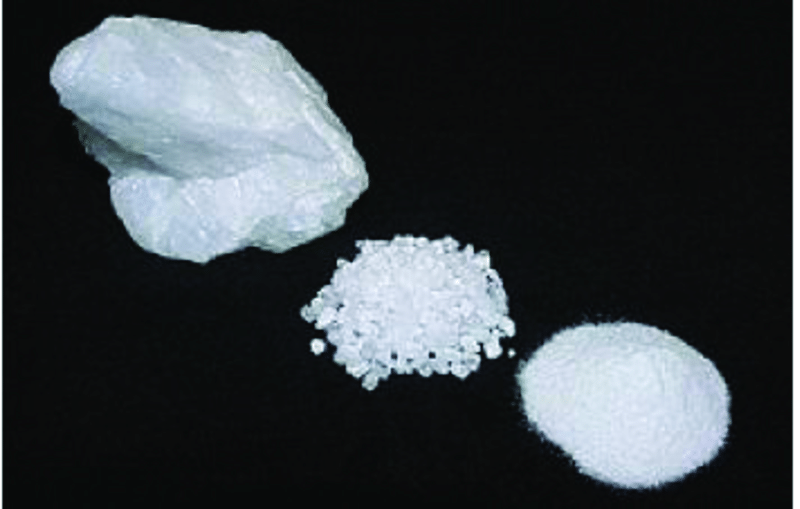Although quartz is one of the most abundant minerals on Earth, high-purity quartz raw materials can only form under geological conditions that meet a specific set of chemical and physical parameters. At present, only a few quartz deposits are suitable for processing into high-purity quartz, and the processing technology is extremely complicated.

To judge whether a quartz ore can be used as a high-purity quartz raw material, it is necessary to use a variety of detection techniques to conduct mineralogical research on the quartz raw material, mainly including:
(1) The distribution characteristics of quartz and gangue minerals, the content of mineral inclusions in quartz minerals is one of the factors that determine the total amount of impurity elements in the final high-purity quartz;
(2) Fluid inclusions, even quartz with a very low content of impurity elements may not be high-purity quartz. When the quartz mineral contains a large number of fluid inclusions, its SiO2 content is difficult to meet the technical requirements of high-purity quartz;
(3) Lattice impurities, because the content of lattice impurities is extremely low but extremely difficult to remove, is the most critical factor restricting the quality of high-purity quartz.
Natural quartz minerals can be divided into granite quartz, high-temperature metamorphic rock-type quartz, metamorphic quartzite-type quartz, quartz formed in the early pegmatite, crystal formed in the middle and late stage of pegmatite, vein quartz in the hydrothermal gas-forming stage, and thermal Aqueous solution phase vein quartz, etc., the characteristics and applications of quartz minerals of different origins are also different.
1. Granite quartz
Features: formation temperature (700℃~1000℃), pure quartz grains, almost no gas-liquid inclusions;
Typical application example: The Processing & Classifying company in the United States used granite quartz in the Foxdele area on the north coast of the United Kingdom to prepare SiO2>99.99%, transition metals<5×10-6, and gas-liquid inclusions (H2O, CO2) content of 89.25-162.8mg/ kg.
2. High temperature metamorphic rock type quartz
Features: formation temperature (750-900°C), low gas-liquid inclusion content;
Typical application example: American Quartz Technology Company uses this quartz raw material to produce high-quality transparent quartz glass.
3. Metamorphic quartzite type quartz
Features: The older the formation time, the more and more intense the thermal events, the purer the quartz and the less gas-liquid inclusions;
Typical application example: Proterozoic quartzite has few gas-liquid inclusions, so it can be considered as a raw material for quartz glass.
4. Quartz formed in the early stage of pegmatite
Features: The formation temperature is 600-700°C, the particle size is generally 2-6mm, transparent, pure single crystal, and less gas-liquid inclusions;
Typical application example: raw materials for Donghai Quartz Glass Tube Factory.
5. Crystals formed in the middle and late stages of pegmatites
Features: forming temperature 500~600℃;
Typical application example: Early high-purity quartz raw material.
6. Veined quartz in the stage of hydrothermal gas formation
Features: Forming temperature 400~500℃, transparent-translucent, less gas-liquid inclusion content;
Typical application example: The commonly used raw material of Donghai Quartz Glass Tube Factory, and the quality of quartz glass products is good.
7. Phase vein quartz in hot water solution
Features: Forming temperature 50-400℃, white-milky white, containing a large number of tiny gas-liquid inclusions;
Typical application example: There are too many gas-liquid inclusions, and the produced quartz glass cannot be used due to too many bubble defects.
Looking at the world, the typical high-purity quartz raw material is the granite pegmatite in the Spruce Pine area of the United States, which is a high-purity quartz deposit formed by the movement of the Alehanni greenschist. Under the influence of the Alehanian greenschist movement, the crustal movement in this area has a significantly different deformation than other areas, resulting in dynamic recrystallization of quartz, plastic deformation of quartz grain crystals, and concentration of interstitial impurities in crystals along newly formed grain boundaries , the liquid that accompanies the deformation movement, facilitates the dissolution and migration of impurities, allowing impurities to be removed from the recrystallized quartz grains.
When quartz deposits are formed, temperature and pressure have an important impact on the quality of quartz, especially in the later stages of quartz formation, high temperature and high pressure are conducive to the migration of impurities inside the quartz grains to the grain boundary edges or fine inclusions, and the fluid inclusions in the formed quartz The volume content is small, and it may have the potential to be processed into high-purity quartz.
